Fossilised dinosaur egg embryos, fish fats on 15,000 year old Japanese pots, who put the arsenic in the beer, and we tour the Malapa cave site where Australopithecus sediba was discovered...
In this episode

01:02 - Beer Filtration Could Add Arsenic
Beer Filtration Could Add Arsenic
A team of researchers led by Mehmet Coelhan of the Weihenstephan research centre at the Technical University of Munich, Germany, has found that brewers might unwittingly be adding arsenic to beer. In research presented at the 245th ACS National Meeting & Exposition in New Orleans, US, Coelhan suggests that the material used to filter beers might add arsenic at the same time as it removes yeast.
A 2008 paper found that levels of arsenic in Italian beer were up to two and a half times the legal limit of 10μg/l in the US and Europe. To investigate where that might have come from, Coelhan's team, whose work at the Weihenstephan research centre focuses on beer related research and carries out a lot of analysis for the brewing industry, analysed nearly 360 samples of beer for heavy metals and found that some had levels over that 10μg/l threshold. However, when the team analysed the water, malt and hops used, they couldn't make the amount of arsenic in those ingredients add up to the level of arsenic in the beers, suggesting that the answer lies in Kieselguhr, the material used to filter the beers after fermentation.
Coelhan's team found that there could be large amounts of 'extractable arsenic' in Kieselguhr, which is a diatomaceous rock made from fossilised algae. Once powdered it is used by brewers to remove yeast and sediment from beer. Some of the kieselguhr that Coelhan analysed released arsenic at up to 12μg/l.
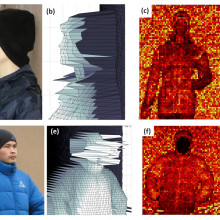
05:56 - High-Res 3D images… From a Distance
High-Res 3D images… From a Distance
Optical imaging techniques have come a long way since the invention of the first light-box, but a standard camera still only produces 2D images. To determine any 3D information, such as the distance to an object, Time-of-Flight (ToF) techniques are used. ToF systems measure distances by bouncing a laser pulse off an object, while timing the pulse's journey, and building an image from the photons received at the detector. Most commercial ToF set-ups have found applications in autonomous vehicles and navigation systems, but have been limited to imaging reflective objects, and over a relatively short range.
But Gerald Buller and his team from Edinburgh's Heriot-Watt University, has designed a ToF system that can produce high-resolution (3D) images of everyday objects from almost a kilometre away, and with centimetre resolution. And because it uses a long-wavelength laser (λ = 1560 nm), the system can be used in daylight conditions, and is also eye-safe.
Reported this week in Optics Express, the system works by sweeping a 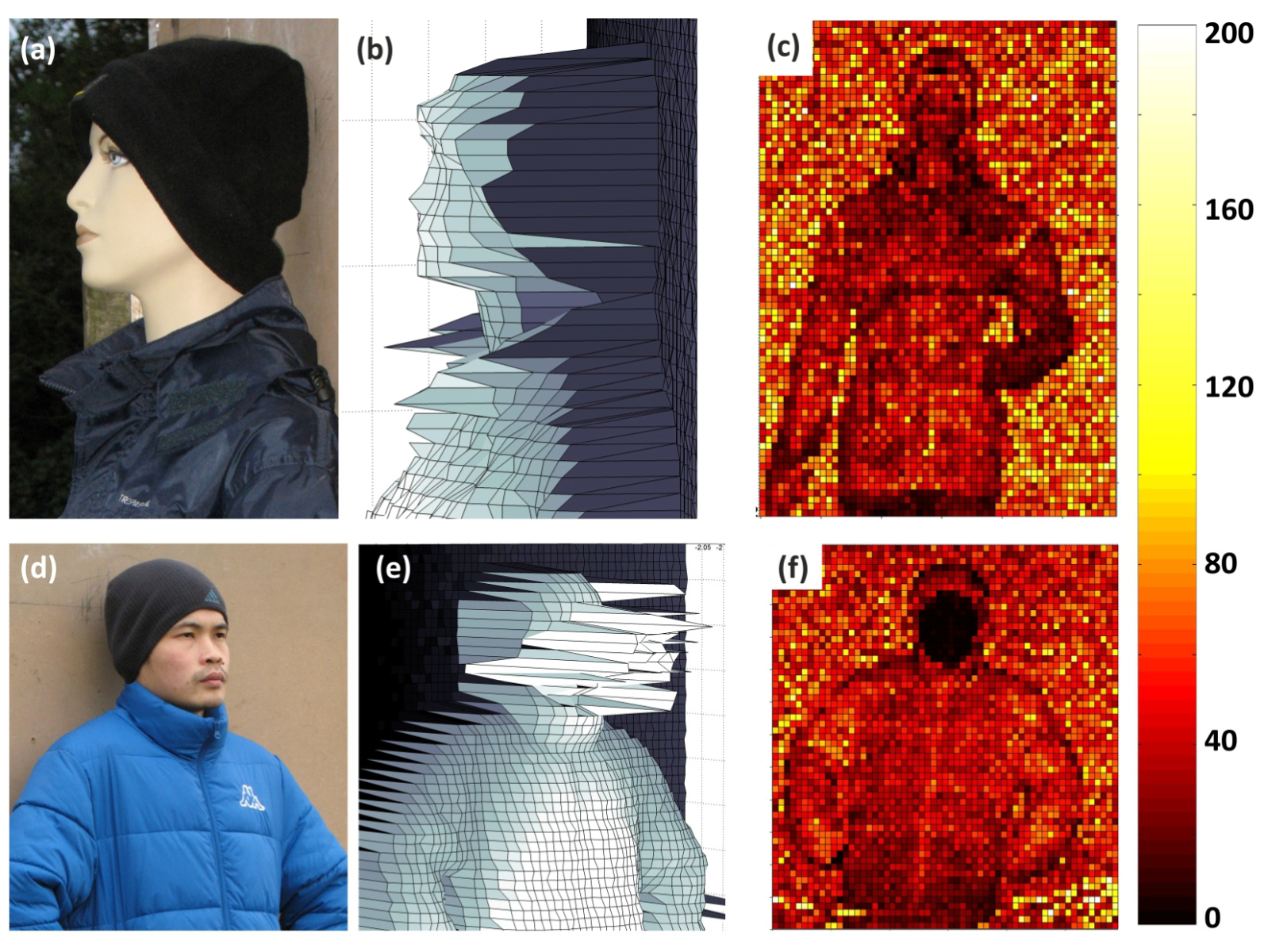 low-power infrared laser beam rapidly over an object. The round-trip flight time of the photons in the beam bouncing back to the detector is then recorded, and an image is built up from single photons, pixel-by-pixel.
low-power infrared laser beam rapidly over an object. The round-trip flight time of the photons in the beam bouncing back to the detector is then recorded, and an image is built up from single photons, pixel-by-pixel.
Other single-photon approaches can also provide exceptional depth resolution, but the key characteristic of Buller's system is that, thanks to its nanowire-based detector, it can image non- reflective objects, such as clothing, vegetation, or rock surfaces. To demonstrate this, 3D images were taken of life sized-mannequins, and some members of the research team. Folds in clothing are clearly visible in the images, confirming that the system operates at centimetre (or potentially millimetre) resolution. But, one thing to note is that at these wavelengths, human skin does not reflect enough photons to obtain a depth measurement.... So this system can't be used to recognise individuals!
Outside of target identification, photon-counting depth imaging could be used for a number of other purposes, including the remote examination of the health and volume of vegetation and the movement of rock faces, to assess potential hazards. And it is expected that the range of this system could be extended to tens of kilometres within the next five years.
Further work will also include reducing the size of system to make it more portable, and improving the acquisition speed. Currently, the entire process takes five to six minutes to complete, but the team have plans to reduce this to just under a minute.
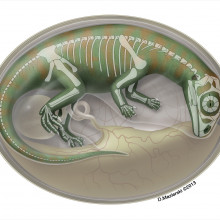
10:28 - Delving into Dinosaur Development
Delving into Dinosaur Development
A chance fossil discovery in Yunnan province in China has yielded one of the oldest and most interesting collection of fossilised dinosaur embryos yet. These fossils, including preserved organic matter and egg shell, can help us to understand how these animals developed in the egg and in early life.
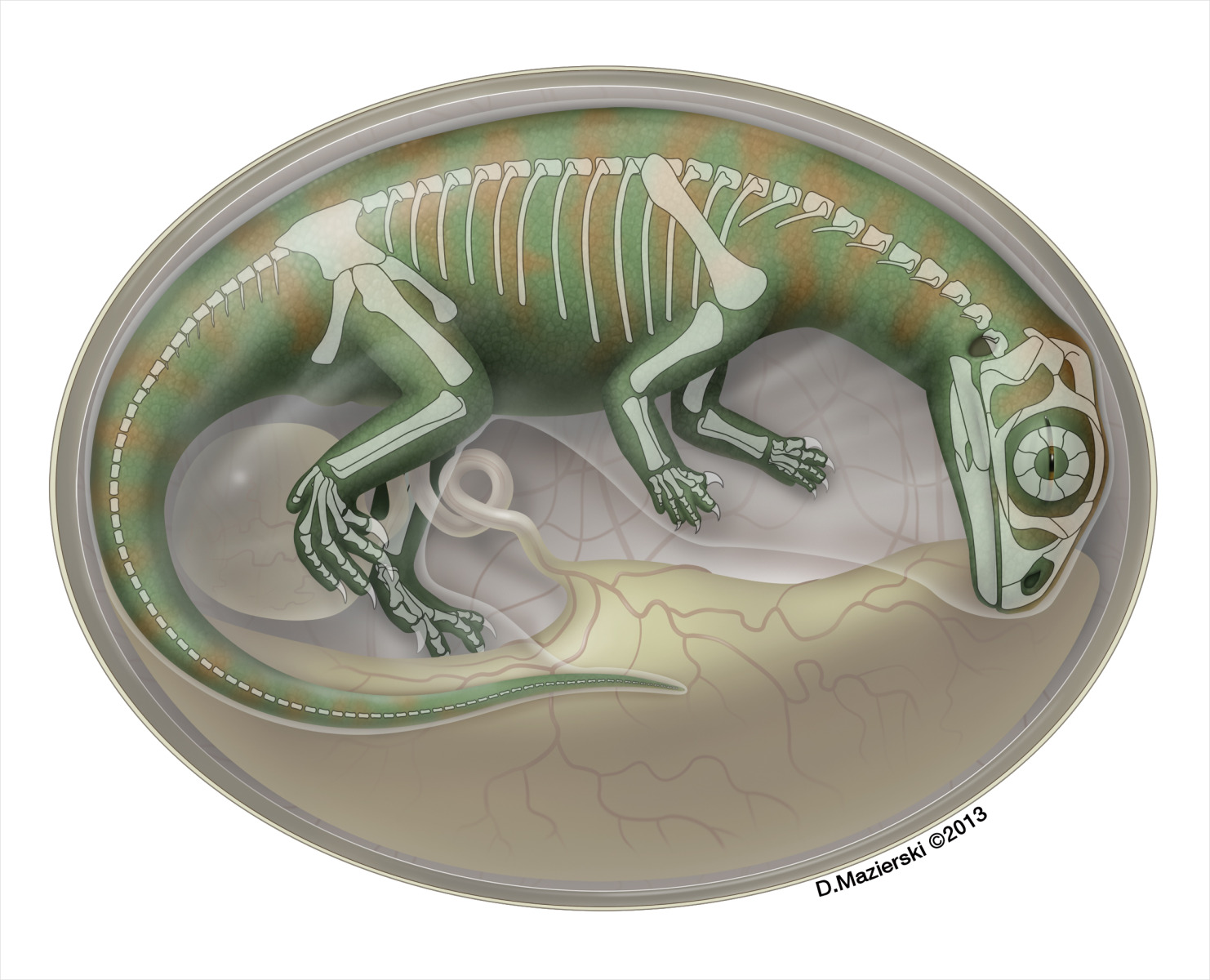 Embyronic fossils are incredibly rare. The bones are delicate and often destroyed before they can become fossils, destroying evidence of dinosaur's embryonic development. This particular find, in the Dark Red Beds of a known lower Jurassic formation, and contain many hundreds of finds, all from a the same species, probably a type of Lufengosaurus. These sorts of single-species finds, known as Monotaxic, are a vital resource for researchers, as even if you don't find a single complete specimen, you will find a range of sizes and ages that can help piece together the life story of the animals.
Embyronic fossils are incredibly rare. The bones are delicate and often destroyed before they can become fossils, destroying evidence of dinosaur's embryonic development. This particular find, in the Dark Red Beds of a known lower Jurassic formation, and contain many hundreds of finds, all from a the same species, probably a type of Lufengosaurus. These sorts of single-species finds, known as Monotaxic, are a vital resource for researchers, as even if you don't find a single complete specimen, you will find a range of sizes and ages that can help piece together the life story of the animals.
The fossils date from the Early Jurassic period, between 190 and 197 million years ago. Robert Reisz and colleagues, reporting in the journal Nature this week, catalogue more than 200 bones and samples of fragmented egg shell. Detailed examination of these bones shows that the dinosaurs would have undergone a period of sustained rapid growth, certainly faster than modern birds or other dinosaurs, suggesting that their incubation times may have been very short.
The way the bones have grown, with strong muscle attachments and asymmetrical cross section, shows that the developing dinos would have been active within the egg, developing the muscles and skeleton that it would need for the outside world. This, combined with the evidence for rapid growth, fits very nicely with the evidence from adult fossils, which were significantly larger than many other dinosaurs at the time.
Enticingly, the researchers have also used a special type of x-ray known as synchrotron radiation to examine the fossils for evidence of preserved organic matter. They have found traces that appear to have been left behind by decaying proteins, which could shed some light on the genetics and biochemistry of these giant lizards.
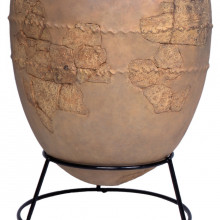
13:02 - Ice Age Pots Give Us A Taste For Fish
Ice Age Pots Give Us A Taste For Fish
Charred fishy food residues have been discovered on ceramic pots that are around 15, 000 years old. The ancient titbits of food provide evidence that people used pots for cooking much earlier than traditional thought and these findings are prompting a rethink of human innovation and culture.
Published this week in the journal Nature, Scientists from the UK, the Netherlands, Sweden and Japan carried out chemical analysis on the ceramic fragments which were found in Japan, a country recognised as one of the first centres for using ceramics.
Originally it was thought that fragile pots were not used to store and cook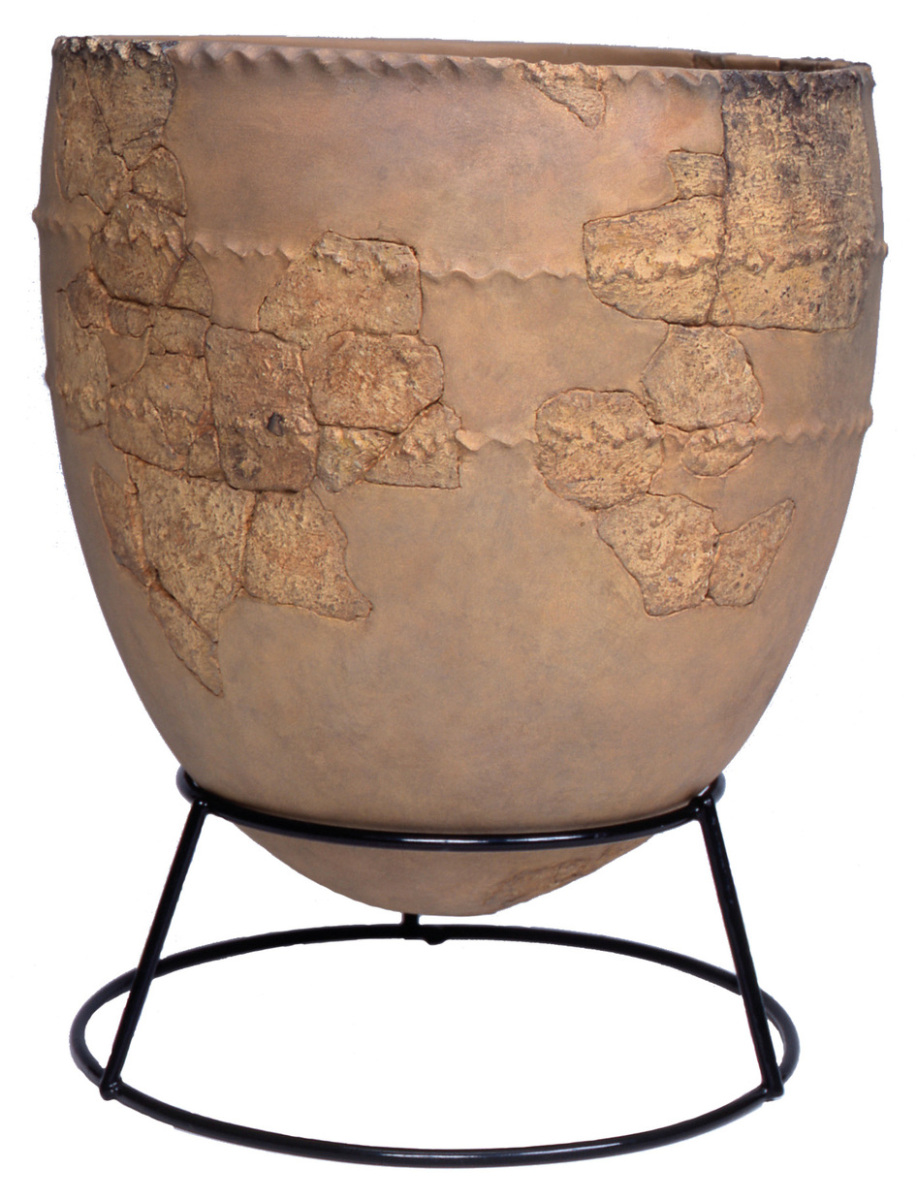 food until farming villages emerged during the Neolithic era, about 10, 000 years ago. But these results suggest that much earlier, the East Asian prehistoric hunter gatherers from the Late Pleistocene Jomon period had already started using pots for cooking, even though they had a nomadic lifestyle.
food until farming villages emerged during the Neolithic era, about 10, 000 years ago. But these results suggest that much earlier, the East Asian prehistoric hunter gatherers from the Late Pleistocene Jomon period had already started using pots for cooking, even though they had a nomadic lifestyle.
The climate was also changing at this time and a new high abundance of fishy food along shorelines and river-banks may have provided the initial impetus to spend time producing ceramic containers. The cooking containers could also be linked to a reduction in mobility as the foragers settled from their nomadic lifestyle.
Dr Oliver Craig from York University and colleagues recovered lipids from the charred surface deposits of the pottery, carbon dated them to determine their age, and then analysed their carbon and nitrogen isotope ratios and the lipids chemical composition using a technique called gas chromatography/combustion/isotope ratio mass spectrometry, which indicated the food remains were freshwater or marine organisms.
The techniques used to scrape out the food remains from the pots, and analyse the material could now be used on other ancient artefacts to tell us more about how our ancestors lived.
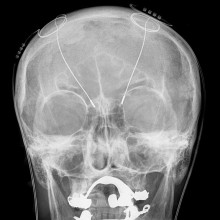
15:41 - Is Free Will an Illusion?
Is Free Will an Illusion?
with Professor Gabriel Kreiman, Harvard Medical School, Boston
How is 'free will' is implemented in the brain? Kate Lamble spoke to Professor Gabriel Kreiman from the Harvard Medical School about his research and started by asking how you nail down such a philosophical question in science...
Gabriel - The type of experiments that we have done follow on from the steps of several other previous scientists who try to reduce freewill to very simple questions. Let's say, I ask you to tap your finger and you can choose exactly when you do that. So, whenever you feel the urge to do that, you can tap on a given key. So, we're asking a very simple question, what, when, how neurons get activated to dictate or determine that particular action?
Kate - How do you measure those neurons? Are you using a skull cap of electrodes or are you using a more invasive procedure?
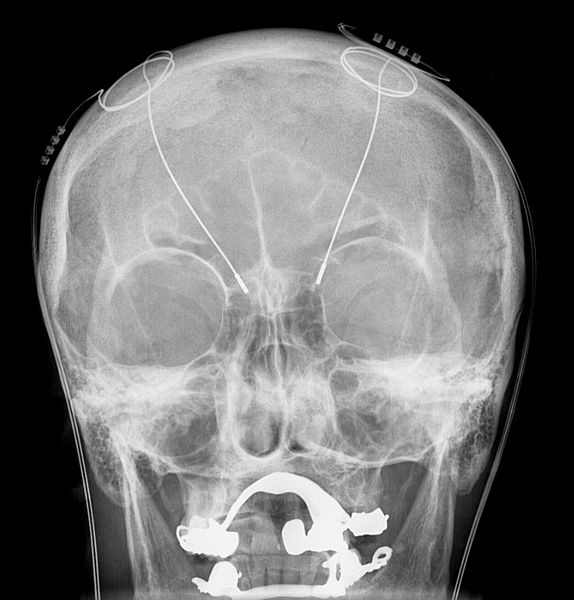 Gabriel - The traditional way to investigate this question has been through scalp electrodes. These are about 2mm contacts that are around the scalp. What we took advantage of is that rare opportunity to peek inside the brain in particular cases of patients that have epilepsy and therefore need to be implanted with electrodes, very thin microwires that can capture and listen to the activity of single neurons and very, very small ensembles of neurons.
Gabriel - The traditional way to investigate this question has been through scalp electrodes. These are about 2mm contacts that are around the scalp. What we took advantage of is that rare opportunity to peek inside the brain in particular cases of patients that have epilepsy and therefore need to be implanted with electrodes, very thin microwires that can capture and listen to the activity of single neurons and very, very small ensembles of neurons.
Kate - So, if you're measuring these neurons as they make the decision whether to click the mouse or not, what are you finding? Are people very conscious of when they make the decisions they want to?
Gabriel - Well, of course eventually, people are conscious about when they make that decision and their subjective report is what we take as the ground truth about what they're conscious of or not. But what we're finding is that neurons in particular parts of the frontal lobe, more specifically an area called the supplementary motor area and the pre-supplementary motor area get activated and are making those decisions for the subject way in advance, way before subjects become conscious of that decision. So, several hundred milliseconds and in some cases, even seconds before people know that they are going to execute that action. The neurons are firing like crazy saying, "Now, we're going to be orchestrating this action."
Kate - You're saying it happening way before, but we're talking hundreds of milliseconds. How long is hundreds of milliseconds in neural terms?
Gabriel - This is sufficiently long that we can ascertain that neurons are making those decisions before people become aware of them. To some extent, all of our decisions, unless we believe in magic, have to be orchestrated by neurons and the particular situation in which we could record and monitor the activity of some of these neurons helps us to tap into some of these populations of neurons that are making these decisions for the subject before subjects actually realise what they're doing.
Kate - So, if our neurons are firing and making the decisions before we're conscious of them, how does that make implications for whether we have free will or not?
Gabriel - The simplest interpretation is that basic physical laws dictate when neurons get activated, when they cross a given threshold that's what ultimately leads to a decision. After the fact, we believe that we are the owners of that decision. We create this illusion of free will, but there's nothing really free in free will. These are neurons that are activated and we can describe with equations what they're doing and when they're activated and so on.
Kate - What's the next step in research? How do we build up to working towards a more complicated action rather than just clicking a finger?
Gabriel - That's very difficult. So, one step that may not sound extremely exciting is to actually ask subjects to choose which hand they want to use. So, not just which finger or when, but they now have a little bit more freedom. Ultimately, we do not think that we can make predictions about what you're going to have for lunch tomorrow or who you're going to marry 5 years from now. So, we're making very simple decisions over very, very small scales with our capability in terms of recordings. So, to some extent, I'd like to come back to a discussion of determinism as well as chaotic systems. We cannot really predict very well when we flip a coin whether it's going land on head or tails, but no one would claim that the coin actually wanted to land one way or the other. It's just a problem that's very sensitive to initial decisions. So similarly, we don't envision anytime soon being able to make predictions on scales of hours or days that are accurate in any way. But that may just simply be problem with technology, how many neurons we can tap into. Ultimately, what you're going to do 5 hours from now may very well depend on a lot of external factors, not just your own brain. But the main point we're trying to make here is that our illusion of free will, may be nothing more or nothing less than ensembles of neurons and circuits firing together in specific patterns.
Kate - It's quite intimidating as a person who thinks that they go around deciding what they do every day. How much does the fact that you're having to work on epilepsy patients and where you put the electrodes are based on clinical opinion, how much does that limit to the next steps of the research that you can do?
Gabriel - We're very limited in many ways. We're limited in which locations we can investigate, we're limited in terms of how many neurons we can record from. On the other hand, one of the only ways in which we can investigate the human brain at this level of resolution.
Kate - Does it have any implications in treatment if we can understand how people make decisions and at what point they make decisions? Can we intervene at any point?
Gabriel - Yeah, that's a fascinating question and we're only taking very preliminary steps in that direction. There's a couple of neurological conditions that involve severe disorders in volition. Parkinson's is the case where people have a lot of difficulty initiating movement. There are many problems in addiction research where again, these are basic decisions that people need to make. So, there has been handful of studies, one by the neurosurgeon that I work with, Itzhak Fried, where they stimulated electrically this particular area and the pre-supplementary motor area. That is they inject that current into the brain, again for clinical reasons in these patients, and people reported that they felt the urge to make a movement. So, in principle, one can bias the activity of neurons and enhance people's abilities or people's intentions to make specific decisions.
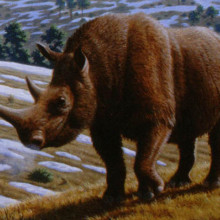
23:47 - Uncovering a British Wooly Rhino
Uncovering a British Wooly Rhino
with Professor Danielle Schreve, Royal Holloway, University of London
When a preserved woolly rhino skeleton was found in a Staffordshire quarry 11 years ago it was described as "the most significant fossil find of a large mammal in Britain for over 100 years."
Planet Earth podcast presenter Sue Nelson went to meet Professor Danielle Schreve at the Royal Holloway, University of London, who led the team that's been studying the find
Danielle Shreve:The animal was dated by radio carbon dating and it has produced a nice cluster of dates around 42,000 years ago which puts it pretty much slap bang in the middle of the last Ice Age. It's an interesting period for us because it's a period of relatively elevated warmth with summer temperatures around 12 degrees centigrade and critically the development of a huge, very rich, tundra environment that has no modern analogue today but which would have suited the rhino and other species around at the time extremely well.
Sue Nelson: This skeleton was found in a quarry, we know it was cold, you say it was in the middle of the Ice Age, obviously it's got its woolly coat that adapted for that sort of weather but give me a picture of what it was like then.
Danielle Shreve: The rhino was found in sand and gravel deposits which were laid down by the River Tame which is a tributary of the modern day Trent and we know that at the time of when the rhino died it was a very open rather barren landscape, certainly treeless and lots of grasses and shrubs that the rhino would have been able to graze on and in particular the river would have been running as a braided cold climate river with many channels and very bare and also rather boggy ground adjacent to the main channels. It's probably as part of that story that the rhino in fact met its doom because like a lot of very large mammals it is very easy for these animals to get mired and we know that because of the excellent state of preservation of the rhino it was buried as a virtually complete carcass and buried extremely rapidly by the sediments and then not uncovered for 40-odd thousand years later.
Sue Nelson: And was it on its own? Was it solitary or did you have any other mammals in the same vicinity?
Danielle Shreve: We found remains of a minimum number of another four individuals of rhino at the site. Also remains of woolly mammoth, of bison, of horse and of wolf.
Sue Nelson: That's a treasure trove really isn't.
Danielle Shreve: It is. I mean it was very unusual to find such a complete find.
Sue Nelson: You discovered this quite a while ago. What have you been studying then that's been able to give you this link between the fossil and effectively the climate at that time?
Danielle Shreve: We've been able to look at the sediments themselves to say something about how the river was depositing sands and gravels and we were also able to collect different palaeobiological proxies, in this case, for example, pollen, plant macrofossil, so things like leaves and seeds, bits of stem but also beetles and the remains of chironomids which are non-biting midges and in particular the beetles and chironomids can give us a very clear idea of vegetation but also of the temperature that was experienced at the time.
Sue Nelson: So how did you work out then what the temperatures were?
Danielle Shreve: Using the beetles and the chironomids today these species that we encountered at the site have very, very narrow temperature tolerances. So by examining the range where these insect species occur today we're able to say very clearly to extrapolate back into the past exactly what the temperature regime was like. Now, for the summer we're looking at summer temperatures of around 12 degrees centigrade. That's roughly 3 degrees cooler than at the present day, but the winter temperatures are much colder, so you're looking at temperatures between minus 16 and minus 22 degrees Centigrade, so extremely savage winter conditions.
Sue Nelson: Was this what you were expecting or did it tell us anything new about what was going on in that particular area at that time.
Danielle Shreve: What we're starting to see with the middle part of the last Ice Age between about 60 and 25 thousand years ago, is that it is a time of very rapid climatic oscillation, shockingly rapid climatic change and so what we're trying to do is with the help of high precision radio carbon dating is to put together a picture of how those climatic oscillations impact on the environment of Britain, impact on the mega herbivores and of course impacted on early humans at the same time. So it's a very interesting time period and the Whitemoor Lake find goes along way to contributing information.
Remains of woolly rhinos themselves are not particularly unusual for the last cold stage but they are often found in caves and they are often heavily gnawed by one of the major predators at the time which was the spotted hyena. In this case we have a superbly preserved, virtually complete, front part of this skeleton that we are able to look at in great detail and also to compare with other woolly rhino material, not only from Britain but also from the adjacent continent.
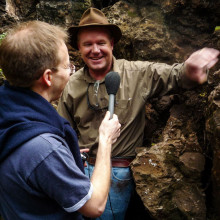
29:13 - Sediba - Exploring Human Origins
Sediba - Exploring Human Origins
with Professor Lee Berger, University of the Witwatersrand
Chris - In 2008, the world of palaeoanthropology took a giant leap forward with the discovery in South Africa of a new species of early hominid. University of Witwatersrand scientist Lee Berger and his son Matthew had been out mapping potential fossil sites in the Cradle of Humankind World Heritage Site near Johannesburg. They had walked along the path made a century ago by miners who had partially excavated one area looking for lime and that's where Matthew spotted a block of stone containing the remains of what is now been named Australopithecus sediba.
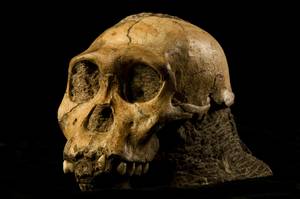 It was a 2 million-year-old specimen of an adolescent male, but with many features that are tantalisingly like our own. That block of stone was lying adjacent to a hole in the ground known as the Malapa Cave. And when Lee Berger investigated further, he uncovered a whole host of remains including an adult female sediba skeleton and many more that have yet to be removed from the site.
It was a 2 million-year-old specimen of an adolescent male, but with many features that are tantalisingly like our own. That block of stone was lying adjacent to a hole in the ground known as the Malapa Cave. And when Lee Berger investigated further, he uncovered a whole host of remains including an adult female sediba skeleton and many more that have yet to be removed from the site.
These individuals died when they fell into the cave possibly because they had been out looking for water. But that meant that the level of preservation is unprecedented. And this week in the journal Science, Lee and his co-workers are publishing further 7 papers describing the findings and how they fill in some very important gaps in our understanding of human evolution. Lee took me to the cave site to show me this incredible place...
Lee - We're walking up this little lime miner's pathway. This little road we're on dates back at least 100 years, maybe a little bit more. It was done by Ox sledges that they were dragging through here in order to access the cave sites. There are actually 86 caves in this little valley that we're sitting in. We can look to the north and see often to the rest of Africa in this beautiful wilderness area and then to the south of us here, a small valley that is littered with these caves and in some cases, fossil sites. The most important one that we've discovered so far is the one that we're walking in. These little shelter of trees that we're just passing under now marks the kind of perimeter of what is now a collapsed cave system. Two million years ago, where we're standing right now, we would've been standing 25 to 30 meters below the surface and over in front of us, if we've been at just the right moment, sometime around 1.977 million years ago, we would've seen a quite horrific death assemblage. There would've been bodies littered all over the surface in front of us - antelopes, sabre-toothed cats, and little mice and stuff. A leaf litter would've lying here and it would've been writhing with insects, feeding on these dead bodies. And stuck amongst them you would've seen figures and bodies of early human ancestors, these Australopithecines. Just over in front of us at about 1 o'clock would've been the body of a young male. He would've been lying just on top of a female who had her legs kicked back and her arms broken, lying underneath. There would've been an infant sitting just a few meters closer to us, lying right next to the body of a false sabre-toothed cat. And that instant is the snapshot that's preserved in time here.
Fast forward 2 million years later and you have the image of flat ground with a small hole in it, bits of these ancient bed rock, the dolomite, collapsed stone because it's all eroded down to expose just right that moment in time. It's within that context that almost cemented in effectively, because that what this rock is that holds them, is this window into our past that accumulated probably over a few weeks, or at most, a few months of perhaps the richest early hominid site on the continent of Africa.
Chris - So, you came walking up this path in 2008 and we've arrived in this little tree lined area and there is a hole on the ground. Is this pretty much what you saw when you walked up it?
Lee - Almost precisely what I saw. In fact, almost exactly where we've stopped. I've been down in 2008 and I picked up a rock that was a sort of the size of a football or rugby ball and I turned it over and there on the other side of it, almost like this rock here was an antelope humerus - the arm bone of an antelope sticking out of it. I was on a mapping exercise that day on the first of August 2008. I looked around and I saw there were other fossils. I took some notes. I took a photograph of the site. I took accurate GPS coordinates, I walked up the hill and found the remainder of caves in this extraordinary environment.
It was only when we returned 2 weeks later with my then 9-year-old son Matthew that I stood on the edge of this pit and as we walk a couple of steps forward, we literally almost recreating that moment when I was standing right here with Job Kibii, my son Matthew and my dog Tau and looking down, I said, "Okay, guys, go find fossils." As you can see around us, there are bits and pieces of this brown rock. That's where the fossils are. The ancient bone is sitting in those rocks and the right thing to do is just start picking up rocks around you right now.
That's not what Matthew and Tau did. They were racing off to the left here, off into that high grass, away from the cave site. It was the wrong place to look, but I think they're off to chase some of these antelopes or giraffes that you've seen on the way. And Matthew stopped by that lightning struck tree. You can see this bizarre little hole in the ground and you can see where the tree has fallen over where it was struck by lightning. He found a rock. He said, "Dad, I found a fossil." I walked over towards him, 5 meters away from him, I realised that his and my life were going to change forever because sticking out of the side of that was the bone I've done my PhD on, a hominid clavicle sticking out of the side of it.
How that rock got there? We still don't know. I don't think it was moved there by miners. There was nothing else in the vicinity of it. Maybe baboons had tossed it, just like the troupe of baboons we saw a few minutes ago. Had tossed it looking for insects underneath it to that point.
Whatever the reason, that block held a not insignificant portion of a skeleton that we would later find littered throughout this area and in place in the wall of this cave just below us, I would then 2 weeks later find the adult female skeleton although we never imagined there were two at that time. And then discovery, after discovery, after discovery.
Now, we have several hundred specimens of these individuals and other skeletons, just from this tiny little hole, and you can see we've done nothing. We have hardly removed anything. Every time we start removing even a tiny bit of this overburden that the miners had dumped on top of here and the couple of blasts that they put in, we find another skeleton and have to stop. It's a fantastic experience as an archaeologist or palaeontologist.
Chris - It's an embarrassment of riches, isn't it? Were the miners not at all aware of what they walking on or walking over, or was there just no realisation at that time, how important this was?
Lee - One of the reasons that we suspect that this was probably late 19th century mining. That is in the late 1890s or turn of the 20th century is that they didn't notice this. If this mining had occurred in the second phase which was after World War 1, sort of 1919 to 1925, by then you started to have an interest in these things, particularly in the third phase which moved into the late 1920s and 1930s. By then people like Raymond Dart were around and Robert Brume. Robert Brume walked this terrain. He was on this farm. He walked in the footsteps of where we've just been. If those miners had found this, I think they would've told him. What is remarkable is how this site was missed and I can't answer that. I missed it for 17 years, but don't think I'm a complete idiot because everyone else had too.
Chris - Shall we take a look at the actual cave site?
Lee - What you're going to see is probably going to disappoint you enormously because it's so tiny. I think everyone who thinks of these sites that had images of these great East African rifts or huge cave sites. But this little wall in front of us which is 2 ½ by 3 meters, that brown area, from that area have come almost more early hominids than in any other spot in the history of this science.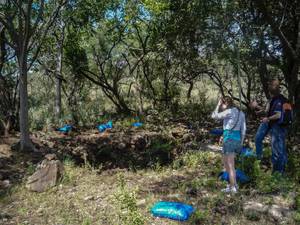
Chris - And this is basically a hole in the ground. It's 3 meters deep. It's maybe 5 meters at maximum extent across each dimension and as you say, an incredibly rich fossil legacy.
Lee - And in fact, only a little part of that. The entire fossil assemblage that have to this date come from just one side of this wall, you'll be able to see an almost body size cavity where we removed her body and part of his body from - although I'm going to actually let you put your fingers on another part of her body. She's still lying there as is he, just above them and that sort of rippled, knotted area, comes little infant hominids. They're lying there and they're still there right now. We haven't removed...
Chris - Is that part of what I can see sticking out just there?
Lee - That's part of a - that's not part of them. That's part of an antelope because there are also other bodies mixed in. It's this stack of bodies that clearly fell and were moved into position but as skeletons. Most of the animals here are articulated. Their pieces are in anatomical position and they're held together by remnants of their organic structure. Can you think how remarkable that is?
Chris - How are you actually going to deal with this, given the enormous amount of material here? Are you going to slowly take pieces out? Are you going to take individual pieces out? Are you going to actually remove enormous amounts on block in the rock and then process them in the lab? How does one tackle this?
Lee - The answer is, I can't answer you yet. We are engaging the entire scientific community around how we're going to do this because there's information preserved in this rock that may actually be one of a kind. It may be utterly unique. We have to be responsible in preserving that. The intent right now is to move with great care at a slow pace. We will attempt to remove large areas or moderate size areas of the rock in front of you and bring them into a controlled environment. So, we will very carefully map out the surfaces. We will very carefully identify where the edges of any one deposit are. We'll try to move it in its entirety, following along natural breaks and fractures. You can see where plants have dug into these, termites have opened this up. We will remove that rock, put it in a controlled environment because there has never been a case at least in our field of science where you are almost guaranteed to make extraordinary discoveries in every piece of rock you touch here.
Chris - But how extensive do you think this is then?
Lee - I don't know that either. That's going to be one of the exciting things about working in the site. I can give you some clues. Nature has given us a road map to this site in the form of these cluster of trees. If you look off to the east here, you can see a large white stinkwood tree that's perhaps 20 meters from us and behind us, this tree cluster goes another say, 10 meters or so. To the north of us, to our left here, towards the lightning struck tree, you can see a grove of trees, and then another 10 or 15 meters to the south of us, that's the perimeter of this cave. Where the trees are growing, the reason they're growing is they've got their feet in fossils. That's why they're there and so, they're signalling to us the potential of this site. And when you get beyond that, you're in that very, very ancient rock. So, what is that? 30 x 30 maybe? We don't know how deep it is, but if the kind of density continues that we're achieving right now, this really will be an extraordinary place.
Chris - I think you need more palaeontologists.
Lee - We do. You know, one of the lessons of this discovery is a poignant one for science. I think that there's so many people, particularly young people today think that we've explored this planet, that we've discovered all of the great discoveries that the age of exploration and discovery are gone. What we will do as individuals is stand on the shoulders of giants and add incrementally to our knowledge because the great age of discovery has ended.
What this site tells us is a very different message than that because it sits right in the middle of perhaps the most explored area, not only on the continent of Africa, but on the planet for these very objects, for sites just like this. It went unrecognised for nearly 100 years and yet, sitting on the surface of the most explored area of the planet, in the middle of it was an object so easy to see that a 9-year-old could pick it up. That held not just another piece of these incredibly rare objects, but maybe the best ones ever found. And what does it tell us about other areas of science? It's got to be true if it's true here.
So Chris, I'm going to let you do something that very few people get to do. You've held the Taung child in your hand. You've touched these sediba fossils. I'm going to let you touch an early hominid in situ, in place, and if you put your hand, you see these little white bones sticking out of this grey rock. If you put your hands on those, you're actually touching the other half of her body still encased in here. There is part of her pelvis. Here's part of her tibia, her shin bone going back in. The remainder of her body sits in here. That is an extraordinary thing because we are so often forced to rip these things from the ground and when we do that, it's a form of destructive behaviour in a sense that the context is lost. Here, you get to see a deliberate choice of us leaving this here for future generations and because we have the other half of her skeleton, we will eventually remove this out. But we may put it in fact in a time capsule. So, you're looking at a time capsule resource. You're seeing the future. I can describe for you what's in that and with the technology we're using, x-ray technology, when this is in the lab, I'll be able to tell you every piece of her that's in here, every position that it occupies. That's extraordinary. We wouldn't have been able to do that if this discovery have been made 10 years ago. Because of its time, we're able to apply technology and decisions about future science that just weren't there for other scientists.
Chris - So, the new batch of research that's going to come out, what will you be reporting next?
Lee - The 7 papers that are coming out in Science continue the sort of extraordinary exploration of the body of sediba. As you know, we've covered kind of the pop critical areas of human evolution. We've done the brain. We began to address the features of the face and taxonomy. We did the hand and it's a remarkably human hand. We did the pelvis because it's so related, how we give birth, how we walk, and we did the foot in those initial descriptions of the morphology. Well now, we get to the nitty gritty of this body. We link all those parts together and so, the series of papers coming out look at the dentition two of them, one is a review of all that has happened to date. We look at the thorax of the chest and its relationship to how sediba was moving across land - was it a runner? Was it walker? Was it a climber? We look at its upper limbs which linked the hand to the rest of the body. We look at the spine, something critical in bipedalism and particularly critical in humans as it's evolved different from all apes. And then we look at the lower limbs finally to assess how was sediba walking. And the short answer to that is, in a way we never imagined before.
When you put sediba together, we see a picture very different than we had predicted from the more fragmentary previous fossil record. We see an animal moving in a bipedal way on two legs, but not in the way we have predicted, and perhaps walking with flatter feet and such. We see an animal with an upper body still adapted to some form of climbing whether that was trees or the cliffs you see or around you and yet all combined, perhaps one of the most mosaic systems of adaptation that we've seen in any mammal every discovered and that's exciting not only because we'd love to see that as evolutionary biologists from any mammal. But to see it in our own lineage is incredibly exciting.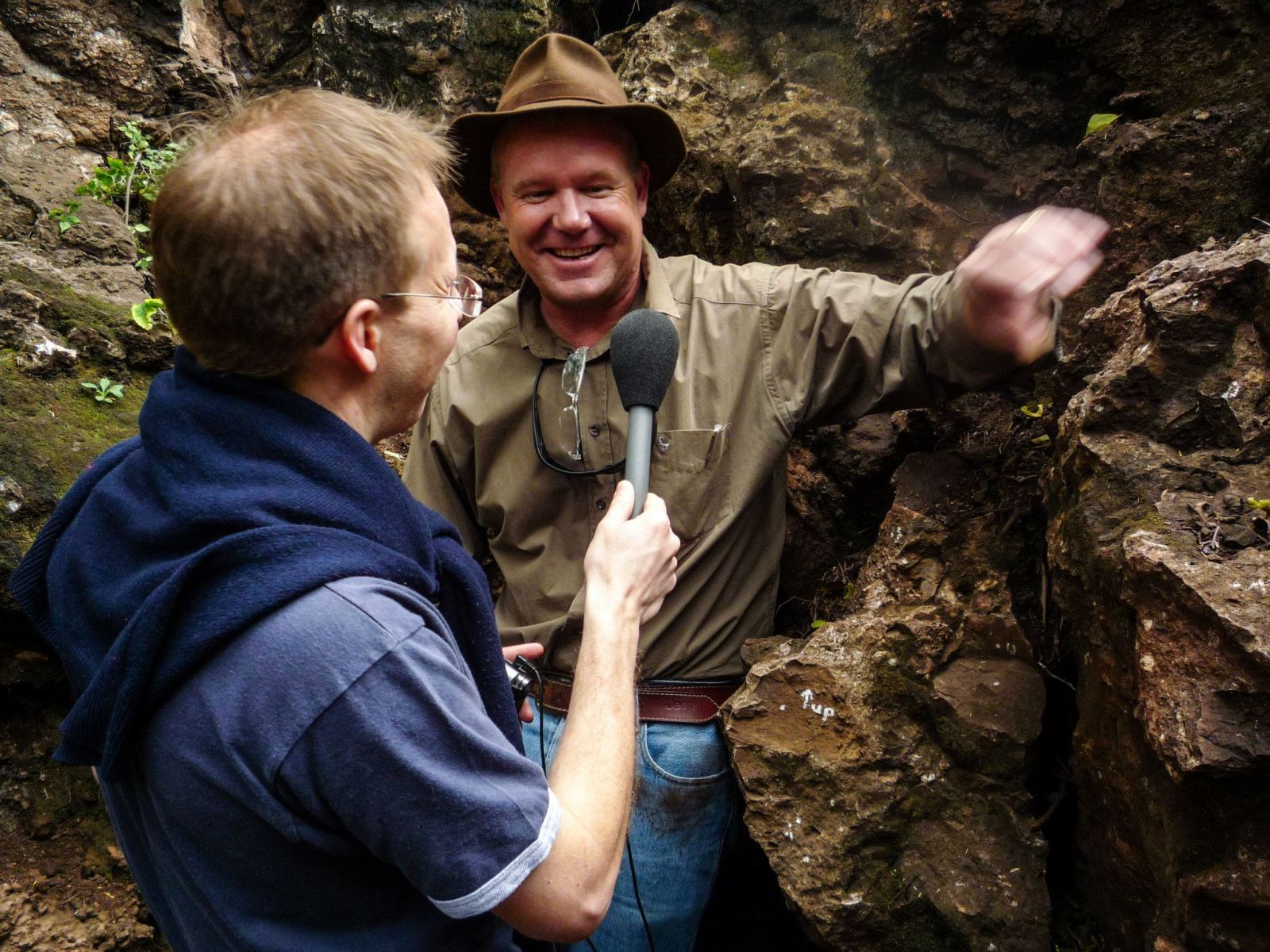
The dentition, we begin to explore where does sediba fit in this great story of human evolution and the answer is that sediba doesn't fit in any clear way to the story we'd been telling from the existing fossil record. It may very well be that ideas that we had that all later species descended from species like Australopithecus afarensis - "Lucy" species may not be correct. That is it does appear that sediba's dentition says it didn't come from at least that lineage of hominids and that may open the possibility of a ghost lineage, the one we haven't found, and that's exciting for palaeontologists.
Chris - So, your reasoning would be that there was Australopithecus afarensis - the "Lucy" specimens that was in parallel with sediba or some other lineage that gave rise to sediba and that could've been the thing that then gave ultimately us.
Lee - Well, the first part of your statement, the idea that parallel lineage appears to be almost certainly true. Then that opens up the next phase of the story and I think that's something that we kind of have to wait and see. Sediba shares a remarkable number of derived characters in really, really, important areas with definitive members of our genus, the genus Homo - its hands, its complex brain, the dental reduction, this unique pelvis, parts of the feet, and limbs. On the other hand, it has a lot of very primitive characters. We just don't know. Are those remarkable coincidences? Are they what scientists call homoplasies? They look similar, but they were evolved from different purposes? Or are they just what they appear to be? That is that they are effectively the progenitors of that morphology in our lineage. Both of those hypotheses are possible as well as perhaps others. It's a wait and see because you've got to remember that the sediba in some ways almost sits in glorious isolation. For 200, 300,000 years on either side, you could put every single other fossil discovered on this continent in a small suitcase and still have room to pack for a weekend away.
Chris - Though the interpretations then, it could be that sediba sits there on its own, it evolved some of the traits we've got for the very same reason that we evolved them, but that Lucy, Australopithecus afarensis, ultimately still gave rise to us and that sediba was just an isolated example or in some way, it is linked to us and was our immediate ancestor and Lucy wasn't, or a combination of those.
Lee - That's right and I mean, there will be probably a point where we have to ask if it walks like a duck, if it quacks like a duck, if it flies like a duck, is it a duck? But sometimes science isn't that easy.
Chris - But how has this, what must amount to a rather controversial interpretation gone down because this field is a small field in a sense that there are some very powerful people working in it, but not many of them. So, how have they reacted to these finds and your interpretation of them?
Lee - Well, I'll tell you tomorrow since these papers are literally probably out as we speak. I can't answer that. I can tell you that no field of science likes its sacred cows slaughtered and palaeoanthropology is no different. Perhaps more so than it has been a field of fragments. It isn't going to be a field of fragments for very long and these fossils form a part of that new generation of evidence.
Chris - I still can't believe I'm standing on 2 million years of human evolution here. What else can I see as I stand in this hole? Just point them out to me because they are pretty subtle. I mean, I wouldn't, if I stood in this hole, have realised there is the bottom half of a female from 2 million years ago.
Lee - Let me try and make it less subtle for you then as we climb up. A lot of reason that it's very subtle in this area is we've removed the various obvious pieces, but I can give you some sense of what's in front of you. This skeleton layer right here, his head...
Chris - So, this is the first one that came out.
Lee - The first one. Literally an arm length away from me, his body, left hand side of his body sits within arm reach of this in front of us at head height. Up here to the left of us where I reach my hand up, just above my head is the foot of another skeleton. There's another child lying right in here and you can see the little bits of yellow bone that represent that articulated foot in position. And then we're going to do some climbing. We're going to climb up the face of this rock only a meter or so and you're going to start seeing fossils that are not so unobvious to you. As we cross on to this little platform which is no more than say, a meter above us, I can have you put your hand on the jaw of a large antelope skeleton that extends here. And here, you can clearly I hope see the teeth of that antelope in place, the shattered remains of its jaws, but what's even more exciting is right next to it. There's - I just push away a little bit of this dirt, you'll see the back of a mandible. You'll see a large tooth in place, that's the head of a sabre-toothed cat. The skull is back in our lab. Its body is still in place extending here. Here, its upper limbs going out in this direction and lying right under where my hand is, which if you imagine almost this cat curled up on its side like a sleeping cat, right underneath my hand is the skeleton of a little sediba baby, about 18 months old. We struck its arm which was lying - its body was lying right on top of this cat and then we stopped because the bones of an infant of that age are incredibly fragile and incredibly precious because we learned so much about the life history. And it's sitting right here underneath this dirt.
Chris - People might think that we're in some giant grotto or something. We're literally almost at surface level again in this pit and this is what? Only a foot below the surface?
Lee - Not even that.
Chris - So, it's extraordinary that it's there and hasn't been weathered away in 2 million years.
Lee - What is extraordinary about it too is that at the rate that this rock is eroding, we had a tiny window in time for this. If we had come 100 years ago, we would not have seen this because the miners wouldn't have opened this up. Literally, we would've walked across this almost in the way we've walked across this trail and we might have seen some trees, but we wouldn't have seen this as special at all. 100 years from now, this will probably be gone. It's that narrow. When you think that we might have had a 200-year window in 2 million years.
Chris - Is an argument for erecting some kind of shelter over this to preserve it because you know, Johannesburg is not known for its gentle delicate weather, is it?
Lee - No and in fact, you might've noticed there are some blue bags and metal upright poles in a sort of semi-circular arrangement around the exterior of this hole. That's going to be a state-of-the-art lab funded by the South African government put over this to protect it and allow us to deal in a paced manner with the extraordinary preservation here - the organic material. The questions you've asked before, how are we going to get this stuff out? Some of it remains to be answered, how are we going to do that. What we do know is it needs protection and that's going to be that.
So, you're at a privileged - very few people come here as you might realise. This area is off limits for very obvious reasons in this beautiful game reserve, but you are some of the last people to come here before this place will be changed forever. It won't be this little natural hole in the ground. It's going to be an active scientific lab within months and so, it's kind of neat to stand here in this pristine wilderness and see the future, but also, get a taste for what the past was like.
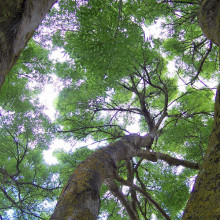
56:05 - Can we achieve artificial photosynthesis?
Can we achieve artificial photosynthesis?
Hannah: So, could we mimic the power of plants to meet our energy demands? With the answer is Helen Woodfield from Cambridge University's Department of Plant Sciences.
Helen: Yes, artificial photosynthesis does indeed exist. Photosynthesis is essentially the means by which energy from the sun is captured and used to split water molecules to generate fuel for the plant to use in growth. What scientists are trying to do is to use the principles from natural photosynthesis to harvest the suns energy and convert it into fuel. The main challenge being met in the field is in the splitting of water.
Hannah: And to find out what splitting of water could be used for we turn to Dirk Mersch, a chemist at Cambridge University.
Dirk: The answer's very simple - if we split water we produce hydrogen, and hydrogen's a much cleaner fuel than the fuels we are currently using, and this fuel can be used, for example, using fuel cells to power cars.
Hannah: Sounds great, so what are scientists busy working on to make this happen then? Back to Dirk.
Dirk:The challenges we are facing at the moment are coming not just from the light harvesting side where we have the same challenges as in solar cells, but also from the catalyst side because the catalysts have to be very efficient and very robust. The catalysts are essential for our devices because they speed up the reaction, (and) in general increase the efficiency of the device. At the moment, platinum catalysts fulfil these criteria. However, they're quite expensive, so what we are working on are cost effective catalysts such as copper based and nickel based ones.










Comments
Add a comment